by W.S. Cranshaw * (7/14)
Quick Facts…
- About 80 different species of lady beetles (a.k.a., “ladybugs” and “ladybirds”) are present in Colorado.
- Adults and larvae feed on a variety of pest insects and mites, notably aphids and scales.
- Lady beetles can be invited into a garden by providing plants that adults use as nectar/pollen sources, sustaining levels of aphids or other prey, and using insecticides with care.
- The Mexican bean beetle feeds on bean leaves and pods. The multicolored Asian lady beetle may be a nuisance when they enter homes during winter, often in large numbers.
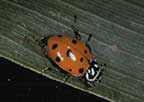
Figure 1: Convergent lady beetle. |

Figure 2: Twospotted lady beetle. |

Figure 3: Sevenspotted lady beetle. |

Figure 4: Pink lady beetle feeding on Colorado potato beetle eggs. |

Figure 5: Coccidophilus atronitens, a predator of pine needle scale. |
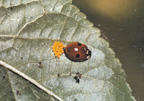
Figure 6: Twospotted lady beetle with newly laid egg mass. |

Figure 7: Lady beetle egg mass in greenbug aphid colony. |
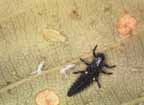
Figure 8: Young lady beetle larva. |

Figure 9: Convergent lady beetle larva. |
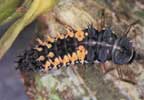
Figure 10: Multicolored Asian lady beetle larva. |

Figure 11: Sevenspotted lady beetle larva. |
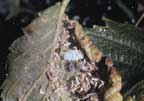
Figure 12: A lady beetle associated with leafcurling aphids. |
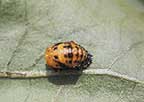
Figure 13: Pupa of a lady beetle. |
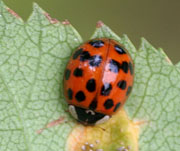
Figure 14: Multicolored Asian lady beetle. |
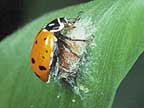
Figure 15: Lady beetle with cocoon of the parasitic wasp Perilitus. |
Lady beetles, also known as “ladybugs” or “ladybird beetles”, are familiar insects. Some 70 species are native to Colorado and about 10 to 12 additional species have established during the past century.
Overwhelmingly, habits of lady beetles are highly beneficial to human interests. Both the adult lady beetles and the grub-stage larvae have chewing mouthparts and are voracious predators of other insects. Although each type of lady beetle has preferences for what they will eat (e.g., aphids, scales, spider mites, mealybugs, etc.), they tend to have fairly broad tastes and feed on almost any small arthropods (insects, mites) or insect eggs that they can successfully attack and ingest.
In general, most commonly observed Colorado lady beetles (the genera Hippodamia, Coccinella, Harmonia, Coleomegilla, Hyperaspis) feed primarily on aphids. Very small lady beetles in the genus Stethorus are important predators of spider mites, although they are not commonly observed. The genera Exochomus, Coccidophilus and Chilocorus specialize in scale insects.
Although lady beetle larvae are strictly predators, adult lady beetles may occasionally supplement this diet by feeding on pollen, nectar, or honeydew. One species of lady beetle, known as the Mexican bean beetle (Epilachna varivestis), feeds solely on plants and is an important pest of beans.
Life History and Habits of Lady Beetles
Most adult lady beetles are easily identified, broadly oval in shape and often brightly colored. Most species are spotted, and the amount of spotting usually is characteristic of the different species. However, there are some important exceptions. For example, the smaller lady beetles that feed on mites (Stethorus) or scales (Coccidophilus, Scymnus) usually are uniformly black or dark brown. A few lady beetle species are even striped.
Lady beetles, as all beetles, develop in a pattern known as ‘complete metamorphosis’. This involves eggs, mobile feeding-stage larvae that molt four times as they develop, transition-stage pupae that undergo changes to the final form, and ultimately the familiar adults.
Most lady beetle eggs typically are spindle-shaped and yellowish or orange-red in color. They are laid in clusters on leaves or other surfaces near aphids and other prey. Lady beetle eggs are distinctive and easily separated from most other insect eggs. However, a few species of leaf beetles produce egg masses of generally similar form–such as the Colorado potato beetle, cottonwood leaf beetle and elm leaf beetle. Small differences in size and color differentiate these from lady beetle eggs. In addition, these leaf-feeding insects restrict their egg laying to the few plants on which they develop; whereas lady beetle eggs can be laid wherever there is nearby insect prey. As with all insects, the development rate depends on temperature and the lady beetle egg stage typically lasts five to seven days. Shortly before eggs hatch, the color changes to more greyish.
Lady beetles that feed on scale insects or spider mites do not lay their eggs in masses. Instead, eggs are laid singly on leaves or under the cover of the scale insect.
Most lady beetle larvae are elongated in form and slightly pointed at the rear. Their legs stick out prominently from the sides, giving the appearance of being somewhat bow-legged. Overall color is gray or black, but most have some distinct spotting of yellow, orange or blue. Fleshy projections extend from the bodies of some lady beetles, notably the twice-stabbed lady beetle and multi-colored Asian lady beetle. The larvae of lady beetles that feed on aphids found in dense colonies of curled leaves, and those that feed on mealybugs ,often are covered with waxy strands and appear similar to mealybugs.
Larvae complete their development in three stages (instars), each separated by molting that typically occurs over the course of 10 to 14 days. After lady beetle larvae finish feeding, they attach themselves to a solid surface by the hind end, head down. They remain motionless and shrink in form, appearing more compact. This stage, called the prepupa, lasts for a couple of days before the insect molts to the pupal stage.
Lady beetle pupae usually are round in shape, attached to a surface by their hind end. The old split skin of the previous larval stage may still partially cover the pupa or, more often, slough off around the base of the pupa. Lady beetle pupae usually are dark orange or red, often with spots. Although the pupa is fixed to the surface at its base and does not crawl or feed, it is not completely immobile and often reacts with a jerk if disturbed. During summer, development of the pupa typically may take about five to eight days.
After the adult emerges from the pupal skin, it is light colored and soft (teneral adult). Over the course of a day or two, the beetle wing covers harden and darken.
Most lady beetles have two to three generations annually and occur throughout the growing season. However, previous to irrigation many common lady beetles are thought to have only one generation per year, synchronized with the flush of aphid populations occurring in spring.
At the end of the season, or when food runs out, adult lady beetles move to winter quarters. This typically is protected sites such as under plant debris, behind bark flaps or walls of homes. During this period (which may last six months or more) the development of the beetle is temporarily suspended, a condition known as diapause.
Some lady beetles also may migrate for winter cover and travel long distances. This habit is particularly notable among the convergent lady beetle, Hippodamia convergens. This species may make summer migrations to the mountains where they spend the winter. Often they will aggregate in large groups, usually around prominent points and often at high elevations, above 9,000 feet. Such mass aggregations annually occur in several Front Range locations in Colorado. Interestingly, they are not observed in the state west of the Continental Divide.
Lady beetles that have only one generation per year live about one year. However, some lady beetles (Stethorus species) are known to occasionally go into diapause and survive a second year. A small number of species spend the winter as larvae. Perhaps the most common example is Coccidophilus atronitens, a predator of pine needle scale.
Purchase of Lady Beetles
A great many nuseries and garden catalogs offer lady beetles for control of garden pests. Essentially all those sold are the convergent lady beetle, Hippodamia convergens. This insect is field collected from mountainous areas of the West Coast states where the beetles periodically migrate and aggregate in large masses when their normal prey are absent in the lower elevations.
Unfortunately, the record for effective use of lady beetles released in a garden is typically poor. One reason for this is that the beetles are highly dispersive, poised to migrate long distances from their collection areas. With few exceptions, expect released lady beetles to fly away from gardens where they have been introduced. Furthermore, these field-collected lady beetles usually are in a state known as reproductive diapause, during which time they do not produce eggs. Only after feeding for several weeks after release do they resume egg laying.
Another concern raised about field-collected lady beetles is that a proportion of them contain a natural enemy of the convergent lady beetle. A small wasp, Perilitus coccinellae, develops as an internal parasite of these lady beetles. Their presence is evident when the larva completes development and subsequently pupates within a cocoon underneath the lady beetle.
Protecting and Encouraging Native Lady Beetles
Far more beneficial than purchasing lady beetles can be steps taken to conserve and enhance the activity of native species. Lady beetles require food for themselves and their young and an important way to encourage lady beetles is to have a source of aphids or other preferred prey for them to feed on. Since lady beetles are actively moving about and seeking food during most of the growing season, they will eventually find your garden.
Adult lady beetles may also feed on other foods, such as pollen and nectar. A garden environment that provides these is also important. Lady beetles most often visit and use shallow flowers that are accessible to their mouthparts, such as dill, coriander or alyssum. Artificial foods, such as sugar-water sprays or mixtures of sugar/water/yeast, are sometimes used to retain lady beetles in a garden.
Sometimes the efforts of lady beetles are inhibited and we can take actions to eliminate these limiting factors. Ants that ‘tend’ aphids and collect their honeydew will often attack and drive off lady beetles and other predators. By controlling ants, lady beetle activity can increase in many cases.
Of course, use of insecticides in and around gardens can also greatly affect lady beetles, which are susceptible to many garden insecticides. Certain selective insecticides, such as Bacillus thuringiensis, soaps, horticultural oils, pyrethrum, and neem are largely compatible with lady beetles.
The Multicolored Asian Lady Beetle
Since the late 1990’s, the multicolored Asian lady beetle (Harmonia axyridis) began to move into and colonize parts of Colorado. Originally introduced to control aphids associated with fruit and nut crops, this insect has steadily expanded its range in North America. The multicolored Asian lady beetle has proved to be an important aphid predator on trees and shrubs in Colorado.
The multicolored Asian lady beetle gets its name because it is highly variable in coloration and patterning. Some beetles are highly spotted, while others entirely lack spotting. The basic color may range from pale orange to a dark red. A white border around the edge of the prothorax also is distinctive. Larvae of this insect also differ somewhat from the “typical” species encountered in Colorado, their body being marked with fleshy spines.
An unfortunate aspect of this insect’s behavior is that it often uses buildings for overwintering shelter. Large masses may be observed in fall, lending to them the popular name “halloween beetles”–a name that reflects both their bright coloration and the time during which they are most commonly encountered. Although they are largely harmless within a home, they can produce a mildly disagreeable odor when disturbed. Fortunately, serious problems with this insect in Colorado have not been reported.
| Table 1. Some of the More Common Species of Lady Beetles Present in Colorado. | ||
| Common name | Scientific name | Comments |
| Sevenspotted lady beetle | Coccinella septempunctata | This is the Ladybird, a European species that has become established in Colorado over the past two decades. |
| Twospotted lady beetle | Adalia bipunctata | A common native species marked with two spots on its reddish wing covers. This species is primarily found on trees and shrubs; less commonn in gardens. |
| Convergent lady beetle | Hippodamia convergens | A native species and the most abundant lady beetle. In parts of the state mass migrations occur during late summer to overwintering sites at high elevation areas. This species is collected from similar aggregation sites in California and are commonly sold by nurseries. |
| Pink lady beetle | Coleomegilla maculata | A generally pink or reddish species with abundant black spotting. It is an important predator of insect eggs and is common in gardens and agricultural crops. |
| Multicolored Asian lady beetle | Harmonia axyridis | A species that has recently colonized parts of the state. Appearance of adults is variable, ranging from being highly spotted to having an absence of all spotting. Overwintering adults often move into buildings, sometimes in very large numbers. |
| Mexican bean beetle | Epilachna varivestis | A plant feeding species that develops on bean foliage and developing pods. |
*W.S. Cranshaw, Colorado State University Extension entomologist and professor, bioagricultural sciences and pest management. 5/01. Revised 7/14.
Colorado State University, U.S. Department of Agriculture and Colorado counties cooperating. Extension programs are available to all without discrimination. No endorsement of products mentioned is intended nor is criticism implied of products not mentioned.
Go to top of this page.




